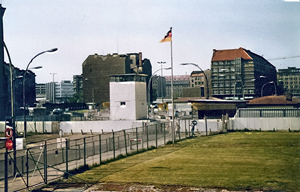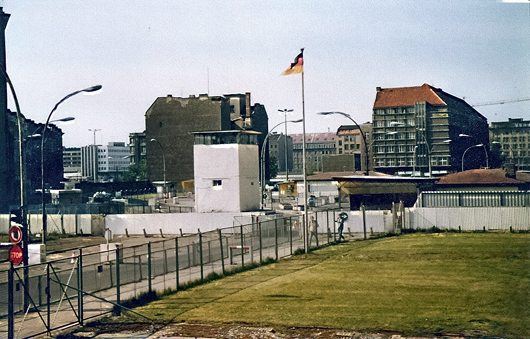
The “BlackBox Cold War” pavilion at the old Allied border crossing between West and East Berlin depicts the decades-long standoff between the communist and capitalist blocs that threatened to end in nuclear Armageddon.
The squat black provisional building will stand for around two years and is intended to provide a test run for a permanent museum that initiators hope can open by 2015 or 2016.
But resistance has developed along ideological lines, reviving 20th century tensions the city thought had vanished with the Berlin Wall 23 years ago.
Jackson Janes, head of the Institute for Contemporary German Studies at Washington’s Johns Hopkins University, said Checkpoint Charlie as the “front line of the Cold War” was the natural site for what he called the first museum of its kind worldwide.
“This thing exists because Checkpoint Charlie is no longer what it was in 1989. Widening the lens makes it clear how that occurred,” Janes told AFP at a preview of the BlackBox.
“We’re saying this was a problem that was overcome by tenacity and commitment to values and to some extent by force.”
Checkpoint Charlie was the site of one of the tensest moments of the Cold War, as U.S. and Soviet tanks faced off in October 1961. The BlackBox portrays the global forces behind that confrontation and puts it on a historical timeline.
But the conservative-led federal government and right-leaning members of the “grand coalition” administration in Berlin believe the Allied Museum, which is moving into former Tempelhof Airport, site of the Berlin Airlift, is a more appropriate setting to document the Cold War.
Critics of the Checkpoint Charlie site argue that it would not focus strongly enough on the U.S., British and French achievements and sacrifices to protect Western Europe from Soviet domination.
They also say that it risks drawing attention away from the private Checkpoint Charlie Museum just down the road which was founded in 1962 as an affront to the communists.
Mayor Klaus Wowereit, who also joined the BlackBox premiere, dismissed such objections as a “black-and-white view of history.”
“This was the site of dramatic scenes as the world held its breath … and feared a new world war,” he said. “There was a global struggle for democracy and freedom and Berlin was the setting for that struggle.”
Backers of a Cold War museum at Checkpoint Charlie include the late Czech former president Vaclav Havel, former U.S. Secretary of State James Baker and Oxford historian Timothy Garton Ash.
The temporary documentation center covers the Potsdam Conference, the Korean and Vietnam wars, the Cuban Missile Crisis, crackdowns on anti-Soviet uprisings and finally the joyous scenes at the Wall’s fall.
It includes an interactive map, dramatic photographs and even clips from evocative movies from the era such as James Bond thrillers and Billy Wilder’s 1961 romp One, Two, Three.
Two slabs of the Berlin Wall, which has largely disappeared from the city’s landscape, stand outside.
Artist Yadegar Asisi will open a 360-degree panorama view of the Berlin Wall this week just opposite the BlackBox intended to give visitors a sense of what it felt like to be in the divided city.
In the years since German unification in 1990, Checkpoint Charlie has turned into what the local press called a “Disneyland” of history, with vendors selling fake Red Army fur hats and gas masks and students dressed in U.S. military uniforms charging tourists for snapshots.
The museum’s initiators say they hope it will restore “dignity” to a site that draws an estimated 4 million tourists each year.
“Well, you certainly see a lot of entrepreneurship here – a everybody’s found a way to make a buck,” said 67-year-old Dick Blouse from North Carolina, surveying what he called a “carnival” at Checkpoint Charlie.
“If you lived through the Cold War like I did then you have so many memories – I think the museum will give this place a lot of its authenticity back.”
ADDITIONAL IMAGE OF NOTE



